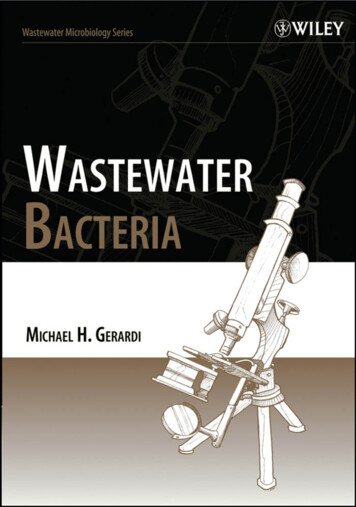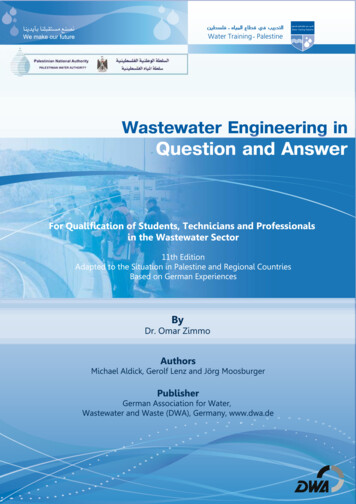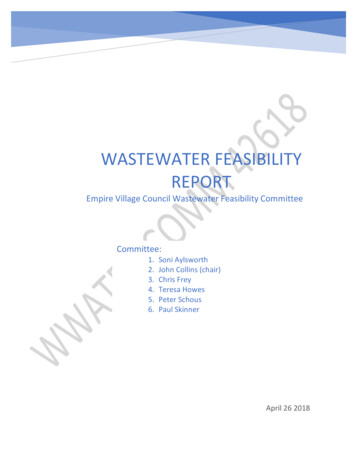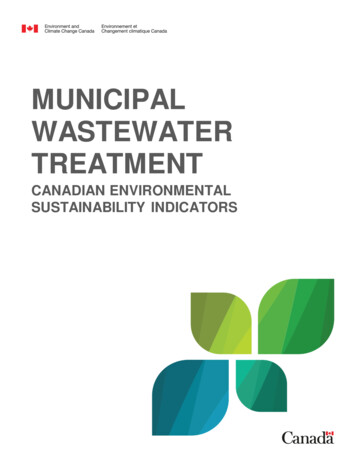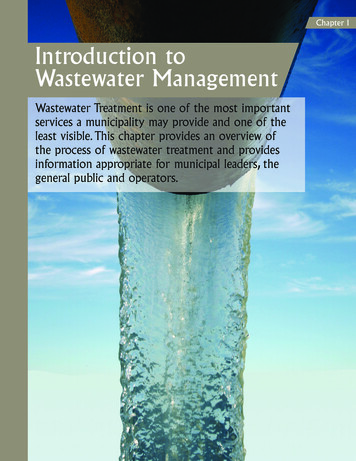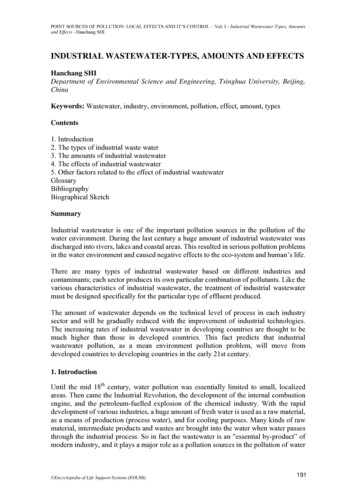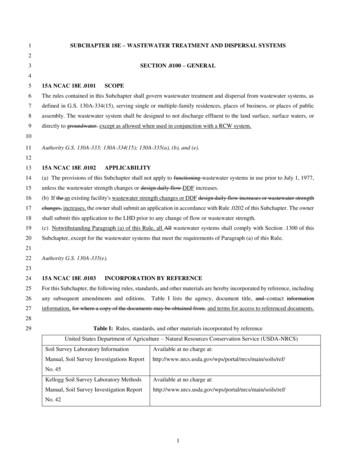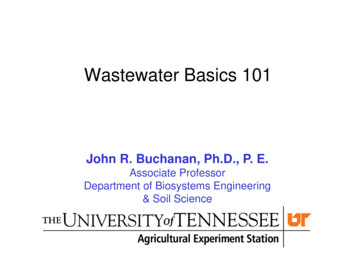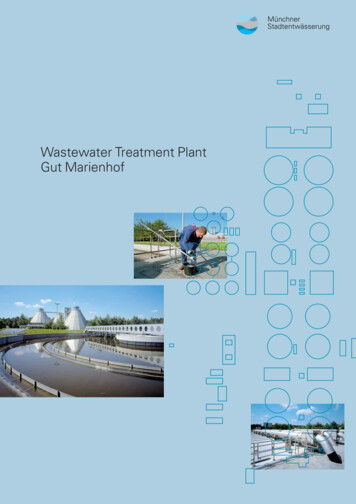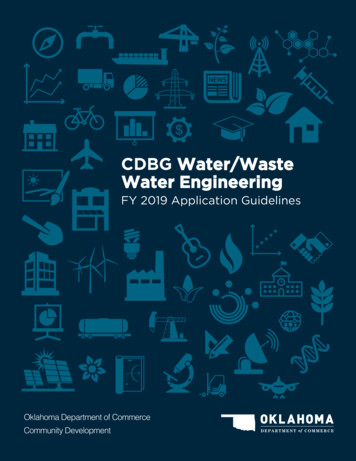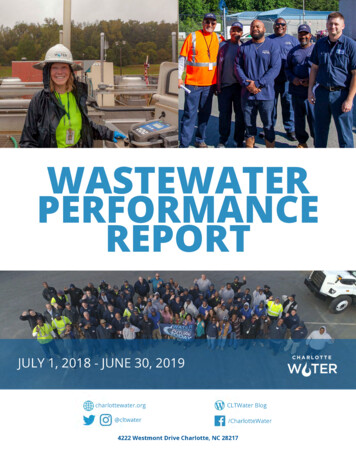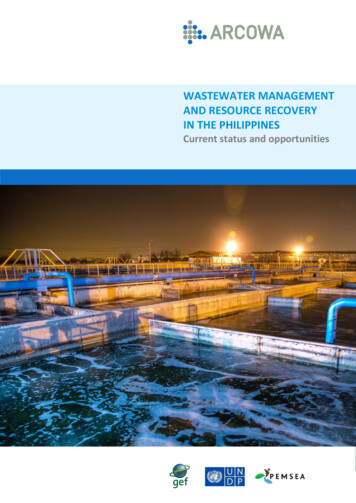
Transcription
WASTEWATER MANAGEMENTAND RESOURCE RECOVERYIN THE PHILIPPINESCurrent status and opportunities
2WA S TE WA TE R M A N A GE M E N T A N D RE S O U R CE RE C OV E RY – T H E P H I L I PP I N E SAbout the author:ARCOWA SA is an advisory firm that offers a fresh approach to sustainable development strategies,solutions and investments. Drawing together diverse people, disciplines and ideas, we translate leadingthinking and practice into world-wide and locally grounded initiatives that catalyze new opportunitiesand investments with a lasting impact. ARCOWA helps creating water security through focusing onmanaging water scarcity and drought under climate change; transitioning wastewater treatment intoresource recovery while safeguarding human health and restore water resources and, applying acombination of green and grey infrastructure to manage freshwater and marine ecosystems andresources.ARCOWA brings together a world-wide network of associates and partner companies. We support thedevelopment and implementation of water and ocean policies and strategies for public entities,businesses and communities. We create new pathways for attractive private and public investments thatenhance the sustainable management of water and oceans. With our clients, we work on project pipelineand program development, implementation, monitoring and evaluation. Using our extensive world-widenetwork of engaged professionals, we facilitate business to business match-making, bi-lateralcooperation and multi-stakeholder engagement. More information: www.arcowa.comPrepared by:G. Bergkamp (ARCOWA, Switzerland) and J. Lim (LCI Envi Corporation, Philippines)Contributions and peer review:V. Vandeweerd and R. Whisnant (PEMSEA)Citation:ARCOWA, 2018. Wastewater management and resource recovery in the Philippines: current status andopportunitiesAcknowledgement:This study forms part of a collaboration between ARCOWA SA and PEMSEA – Partnerships inEnvironmental Management for the Seas of East Asia. PEMSEA, supported by the GEF and UNDP, aimsto foster and sustain healthy and resilient coasts and oceans, communities and economies across theSeas of East Asia through integrated management solutions and partnerships. As the regionalcoordinating mechanism for the Sustainable Development Strategy for the Seas of East Asia (SDS-SEA), ashared marine strategy among 14 countries in the region, PEMSEA works with national and localgovernments, companies, research and science institutions, communities, international agencies,regional programs, investors and donors towards implementation of the SDS-SEA. PEMSEA appliesintegrated coastal management (ICM) as its primary approach for generating and sustaining healthyoceans, people and economies. The current report forms a contribution to the further development ofan ocean investment facility that aims to mobilize investment in the seas of East Asia’s blue economy.More information: www.pemsea.orgThis report is based on the review of a wide range of documented sources and discussions withrepresentatives from a large number of agencies, companies and organizations. All those that providedinput into this assessment are kindly acknowledged for their valuable inputs, insights and foresights thatformed the underpinning of this report.Disclaimer:This document has been prepared on the basis of information available to ARCOWA SA at the date ofpublication. ARCOWA SA makes no warranties, expressed or implied, in relation to any informationcontained in this document. This document does not purport to represent commercial, financial or legaladvice, and should not be relied upon as such. ARCOWA SA does not accept responsibility or liability forany loss, damage, cost or expense incurred or arising by reason of any party using or relying oninformation provided in this document. Any party that uses information contained in this document forany purpose does so at its own risk. The views expressed in this publication are those of the author andnot necessarily those of PEMSEA and its partners.Contact:ARCOWA SA, Rue de Collège 18, 1260 Nyon, Switzerland admin@arcowa.com www.arcowa.comCopyright ARCOWA 2018 All rights reserved.
W A S TE WA TE R M A N A GE M E N T A N D RE S OU R CE RE CO V E RY – TH E P H I L I P PI N E S3CONTENTSEXECUTIVE SUMMARY5Institutional and operational changes requiredFinancial changes requiredTechnological and capacity changes required5671INTRODUCTION92GENERAL STATUS OF WATER RESOURCES IN THE PHILIPPINES113URBAN AND INDUSTRIAL WASTEWATER MANAGEMENT153.1 Urban wastewater3.2 Industrial wastewater1517EXPERIENCES WITH RESOURCE RECOVERY FROM WASTEWATER234.1 Water re-use4.2 Bio-energy4.3 Nutrient Recovery232426INSTITUTIONAL SETTING295.1 New development strategy5.2 Institutional framework5.3 Policies, laws and regulations293031NATIONAL CAPACITIES ON WASTEWATER SERVICES356.1 Contractors, service providers and consultants6.2 Training providers and networks3536WASTEWATER TARIFFS AND INFRASTRUCTURE FINANCING397.1 Water and wastewater tariffs7.2 National financing7.3 International financing394142CONCLUSIONS AND RECOMMENDATIONS458.1 Conclusions8.2 Recommendations454645678
4WA S TE WA TE R M A N A GE M E N T A N D RE S O U R CE RE C OV E RY – T H E P H I L I PP I N E S
W A S TE WA TE R M A N A GE M E N T A N D RE S OU R CE RE CO V E RY – TH E P H I L I P PI N E S5EXECUTIVE SUMMARYResource recovery from wastewater provides a significantopportunity in the Philippines. Overcoming some of theinstitutional barriers, operational shortcomings and financialconstraints are critical to expand wastewater treatment andreduce pollution. Capitalizing on the new technologies torecover valuable resources from wastewater provides a newimpetus for the sector and improve its financial viability.The Philippines has enjoyed an abundance of water. Yet projected wateravailability and demand shows significant future water shortages for manyurban areas throughout the country. At the same time, water pollution isseriously affecting surface and groundwater sources and coastal zones.There is a growing consensus that action needs to be taken urgently and thatsignificant steps need to be made to change the current conditions.INSTITUTIONAL AND OPERATIONAL CHANGES REQUIREDKey findingsA broad set of regulations, decrees, acts, orders and codes are in place thatregulate wastewater management and aspects of resource recovery. A neweffluent standard existing since 2016 provides a major opportunity for newand upgrading existing wastewater facilities and including resourcerecovery. However, the enforcement of existing regulations is hampered bythe limited (financial) capacity of relevant agencies and implementingmechanisms.Local governments have the responsibility to set-up adequate sanitationsystems. However, few local governments or Water Districts haveimplemented sewerage or effective septage management schemes as theyhave limited capacity and weak incentives to comply with existingobligations and standards.Recommendations Concerted action is required by government to promote, supportand incentivize the use of advanced wastewater treatment andresource recovery technologies. To foster further expansion of wastewater collection and treatment,further reform of the sector needs to be accelerated, includingthrough nominating a single lead agency for urban sanitation,establishing a single regulator for the sector, and amalgamatingmany local service providers in smaller municipalities. For municipalities and industries located in areas with (future) waterscarcity, more effort should be focused on wastewater re-use in
6WA S TE WA TE R M A N A GE M E N T A N D RE S O U R CE RE C OV E RY – T H E P H I L I PP I N E Sparticular for applications in industrial and agriculture settings. Thisrequires a better cooperation between municipalities and theirutilities and industrial establishments and agriculture producers forthe off-take of treated wastewater for re-use.FINANCIAL CHANGES REQUIREDKey findingsTo move towards universal coverage of sanitation services during the period2015 - 2028, the total investment required is USD 619 million per year.Limited national financing is available compared to the financial resourcesrequired to achieve full coverage of wastewater collection and treatment inthe Philippines.Water re-use can avoid or delay expensive development of new waterstorage and supply infrastructure required to address growing water scarcityin the Philippines. Bio-energy generation from combined wastewater andorganic waste could significantly reduce wastewater utilities’ operatingcosts by reducing their power purchases.Recommendations Further guidance and promotion of investments in wastewatersystems is urgently required. There is an opportunity to useavailable government financing more effectively. Municipalities, industrial zones and utilities need to invest infeasibility studies to accelerate the recovery of bulk-water, theproduction of bio-energy, the creation energy-efficiency and therecovery of nutrients from wastewater. There is an opportunity to attract additional ‘green’ financingrelated to renewable (bio) energy to the wastewater sector. Theexisting programs with a number of national banks in the Philippinesfor financing water, wastewater and septic management need tocontinue and expand. In addition, the growing interest of national and foreign privatecompanies to invest in the water sector needs to be harnessed toco-finance wastewater treatment and resource recovery systems ata larger scale. There is a need to further diversify financing mechanisms forwastewater treatment and resource recovery in the Philippines,including through the involvement of national and internationalprivate sector financing. To attract additional national private financing and foreign directinvestments in the sector, further tariff reforms will be needed toallow utilities a more attractive rate of return. Such reforms willneed to go hand-in-hand with improvements in utility performanceand service delivery. Outcome based financing could be a valid
W A S TE WA TE R M A N A GE M E N T A N D RE S OU R CE RE CO V E RY – TH E P H I L I P PI N E S7pathway for attracting additional financing to achieve agreed upontargets.TECHNOLOGICAL AND CAPACITY CHANGES REQUIREDKey findingsImportant experiences exist and expertise is available in the Philippines withregards to wastewater treatment and resource recovery. However, resourcerecovery from wastewater is not a common practice in the Philippines todate.Recommendations To capitalize on the opportunity to generate bio-energy fromwastewater, a more rapid transition from septic tank systemstowards centralized wastewater collection and treatment needs tobe put in place, especially for the larger, densely populated urbanareas. Government and business need to initiate new pilot schemes for theproduction of bio-energy, water re-use and high-quality fertilizerfrom wastewater. Cooperation between utilities, research centersand technology providers needs to be established to test and gainexperience with the use of advanced technologies in this regard. New capacities for designing, building and operating advancedwastewater treatment and resource recovery facilities is required.Environmental engineering educations and professional updatingcanters need to pay more attention to advanced wastewatertreatment and resource recovery.
8WA S TE WA TE R M A N A GE M E N T A N D RE S O U R CE RE C OV E RY – T H E P H I L I PP I N E S
W A S TE WA TE R M A N A GE M E N T A N D RE S OU R CE RE CO V E RY – TH E P H I L I P PI N E S91 INTRODUCTION1Investing in wastewater treatment facilities has been shown tobe profitable. New technologies are available to extract water,energy and nutrients from wastewater streams.Effective management of wastewater remains a persistent problem in EastAsia, with discharge of untreated wastewater from domestic, industrial, andagricultural sources a common occurrence. Across Asia, a majority of sewagestill finds its way to the rivers, lakes, coastal zones and oceans without anytreatment. The impacts on freshwater, coastal and marine ecosystems andcommunities have been significant, including hypoxia, loss of fisheriesproductivity and biodiversity, and impacts on human health. Properwastewater management in river basins and coastal areas presents acomplex challenge involving aspects of policy, governance, behavior andinvestment.Investing in wastewater treatment facilities, however, can be profitable.New technologies are available to extract water, energy and nutrients fromwastewater streams. Products derived from these can be marketed to makethe treatment of wastewater —a service each municipal government shouldprovide to its citizens and each industry should actively implement — aprofitable business not depending only on government taxes and tariffs.Indeed, combining wastewater treatment with recovering water, energyand nutrients has the potential to provide commercially acceptable returnson investments.While the business case for recovering resources from wastewater has beenproven in particular cases at demonstration, pilot and full-scale applications,there is a need to further understand the potential for wastewatertreatment and resource recovery in East Asia.To that end, country overviews of wastewater management and resourcerecovery have been prepared for three countries in East Asia: thePhilippines, Vietnam and Indonesia. This report, focuses on the Philippines,and aims to improve the understanding of its urban and industrialwastewater sector as a basis for further analyzing opportunities to invest inwastewater treatment and resource recovery. It thus forms an initial step inthe potential mobilization of public and private investments in wastewatertreatment and resource recovery in the Philippines.Key questions that the report addresses include: What is the current status of water resources in the Philippines? What are the common characteristics of urban and industrial wastewatermanagement in the Philippines? What are the in-country experiences to-date with different aspects ofwastewater resource recovery, including water re-use, bio-energyproduction and nutrient recovery?
10WA STE WA TE R M A N A GE M E N T A N D RE S O U R CE RE C O V E R Y – TH E P H I L I PP I N E S What is the institutional and regulatory setting for development of thewater and wastewater services sector in relation to wastewatertreatment and resource recovery? What is the capacity at the national level regarding wastewatermanagement and resource recovery? What are potential sources of (co-)funding for wastewater treatmentfacilities in the Philippines?The report has been prepared based on extensive desk studies anddiscussion with key actors in the water and wastewater sector in thePhilippines.This study forms part of a collaboration between ARCOWA and PEMSEA –Partnerships in Environmental Management for the Seas of East Asia. Itforms a contribution to the further development of an ocean investmentfacility that aims to mobilize investment in the seas of East Asia’s blueeconomy. The East Asia Ocean Investment Facility (EAOIF), managed byPEMSEA, offers investment services to local governments and projectstakeholders, as well as regional and global investment funds, assisting inthe identification, development and consolidation of blue economyinvestment projects in East Asia. The EAOIF targets development of projectsthat are financially sustainable and generate measurable positive social andenvironmental impact.
W A S TE WA TE R M A N A GE M E N T A N D RE S OU R CE RE CO V E RY – TH E P H I L I P PI N E S2112 GENERAL STATUS OF WATER RESOURCESIN THE PHILIPPINESThe Philippines has enjoyed an abundance of water. Yetprojected water availability and demand shows significantfuture water shortages for many urban areas throughout thecountry. At the same time, water pollution is seriously affectingsurface and groundwater sources and coastal zones. There is agrowing consensus that action needs to be taken urgently.Historically, the Philippines has enjoyed an abundance of water. However,this is likely to change in the near future. It is estimated that in 2025, wateravailability will be marginal in most major cities and in 8 of the 19 major riverbasins in the country (see Table 2.1). The water availability per capita of1,907 cubic meters is the second lowest in Southeast Asia with the bulk ofwater demand coming from irrigated agriculture.The situation is particularly challenging for Metro Manila. Here, the AngatDam supplies 97 percent of the Metropolitan Waterworks and SewerageSystem (MWSS) service area. By 2025, the projected water demand in MetroManila is expected to have risen further, requiring the development ofsupplementary sources of water.Table 2.1 Water demand in major cities of the Philippines 191-82-93Baguio City12871521-83Metro Cebu59342602-82Zamboanga City282035492-73Cagayan De OroCity29983418-65Davao501538369-45Bacolod City37111103179-7Iloilo City9478078870Metro ManilaThe water supplies for eight other urban areas (Metro Cebu, Davao, Baguio,Angeles, Bacolod, Iloilo, Cagayan de Oro, and Zamboanga) are also at criticallevels, according to various studies. However, consensus has been achievedin several focus group discussions and public forums on the need to identifyreform measures to alleviate the looming water crisis in these major cities.1World Bank 2003. Philippines Environmental Monitor.
12WA STE WA TE R M A N A GE M E N T A N D RE S O U R CE RE C O V E R Y – TH E P H I L I PP I N E SThe situation with water quality also raises concerns. Of the 421 rivers in thePhilippines, 50 are considered by the Department of Environment andNatural Resources (DENR) as “biologically dead”. Recent studies show that13 percent of surface water bodies in the Philippines have poor waterquality, 40 percent have a fair quality and 47 percent have a good waterquality2. 58 percent of the groundwater is contaminated resulting inpollution of waterways and sub-soils. Due to the deterioration of waterquality, many water bodies are now un-fit for their intended uses, such aspublic water supply, food production, or recreation.The annual economic losses caused by water pollution are estimated at PHP67 billion (USD 1.3 billion)3. These include PHP 3 billion for health, PHP 17billion for fisheries production, and PHP 47 for tourism. With a GDP off USD300 billion per year this represents ca. 0.5 percent of GDP. An example forthis is the “Boracay Island” issue that emerged in April 2018 and whichincluded a government order to close the island for tourism activities untilproper treatment and disposal of wastewater is put in place.The main sources of water pollution include: untreated domestic (also called‘municipal’) wastewater discharges (33 percent), industrial sources (27percent), agriculture and livestock (29 percent), and non-point sources suchas agricultural farms (11 percent). Pollution is classified as either ‘pointsources’ with emissions of harmful substances directly into a particularwater body, or ‘non-point sources’, with pollutants delivered indirectly tosurface water bodies from scattered or non-identifiable sources.The pollution of Philippine waters comes for a significant part from untreateddomestic and industrial wastewater. Only about five percent of householdsare connected to sewerage networks and treatment facilities 4. In MetroManila alone, approximately 2,000 cubic meters of solvent wastes, 22,000tons of heavy metals, infectious wastes, biological sludge, lubricants, andintractable wastes, as well as 25 million cubic meters of acid/alkaline liquidwastes are improperly disposed of annually5.To address the water pollution challenge, the Clean Water Act was enactedin 2004 to focus on the issues of wastewater and septage management. Thisresulted in the preparation in 2010 of the National Sewerage and SeptageManagement Program (NSSMP). To address the issue, the DENR furtherestablished designating Water Quality Management Areas (WQMAs) thatare prioritized for immediate rehabilitation and protection from pollutionsources (see Figure 2.1).2Greenpeace, 2007. State of the water resources in the Philippines.WSP, 2015. Water Supply and Sanitation in the Philippines Turning Finance into Services for theFuture.4NEDA, 2017. Philippines Development Plan 2017 - 20225UNIDO, 1999. Industrial Policy and the Environment in the Philippines, a paper prepared for theGovernment of the Philippines. UNIDO consultants Paul Hesp and Richard S. Stevenson (ed.). UNIDO3
W A S TE WA TE R M A N A GE M E N T A N D RE S OU R CE RE CO V E RY – TH E P H I L I P PI N E S13Figure 2.1 Water Quality Management Areas in the Philippines.However, urban and industrial wastewater collection and treatment in thePhilippines continues to pose a great challenge. According to the PhilippineSustainable Sanitation Roadmap (2010) prepared by the National Economicand Development Agency (NEDA) and the Department of Health (DOH), only10 percent of the collected wastewater is treated prior to disposal. Despitehaving multiple organizations focused on wastewater management, there isstill significant lack of wastewater collection and treatment facilities becauseof low investments in the required infrastructure.While Local Government Units (LGUs) recognize the need to developwastewater treatment, they are constrained by high investment andoperating costs. Citizens unaware of the benefits of proper wastewatertreatment are largely unwilling to pay for sanitation and wastewatertreatment services. Also, the limited availability of space for sewer lines andwastewater treatment facilities, especially in densely populated, lowincome areas, result in sewage being disposed of indiscriminately. Inaddition, most of the government budget available for water services isdirected towards the provision of water supply services (97 percent), leadingto a lack of financing available for sewerage and sanitation6.6World Bank, 2003. Philippines Environment Monitor.
14WA STE WA TE R M A N A GE M E N T A N D RE S O U R CE RE C O V E R Y – TH E P H I L I PP I N E S
W A S TE WA TE R M A N A GE M E N T A N D RE S OU R CE RE CO V E RY – TH E P H I L I P PI N E S3153 URBAN AND INDUSTRIAL WASTEWATERMANAGEMENT36 percent of the total population, 27 million people, have noaccess to "improved” sanitation.Only 10 percent of wastewater is treated and only 5 percent ofthe total population is connected to a sewer network. The vastmajority uses flush toilets connected to septic tanks.Water and wastewater services in the largest urban areas( 400,000) are mostly operated by national private operators.Others are serviced by city water districts, including throughcontracting private service providers.There are 370 Special Economic Zones hosting 3,398companies. Each Special Economic Zone needs to operate acentralized wastewater treatment facility within the industrialpark.3.1 URBAN WASTEWATERUrban wastewater collection and treatment in the Philippines continues topose great challenges. In the Philippines, only 10 percent of wastewater istreated7 and only 5 percent of the total population is connected to a sewernetwork. The vast majority of Philippine’s population uses a flush toiletconnected to a septic tank. Since sludge treatment and disposal facilities arerare, a large part of domestic wastewater is discharged without treatment 8.In fact, 84 percent of the urban population discharges wastewater to septictanks and only about 10 percent of the septage is treated, most of which isin Metro Manila. In 2015, 36 percent of the total population (ca. 27 millionpeople) had no access to "improved" sanitation9.Domestic effluents are generated from activities such as bathing, laundry,cleaning, cooking, washing, and other kitchen activities. This contains a largeamount of organic waste with suspended solids and coliforms. Calculationsmade based on available data show that half the organic waste is from thedomestic sector (see Annex 1). Domestic wastewater discharges contributehighest to the Biological Oxygen Demand (BOD) load in surface waters. Thisis due to the fact that 90 percent of domestic sewage is discharged intosurface waters without going through a sewage treatment system.7NEDA and Department of Health (DOH), 2010. Philippine Sustainable Sanitation Roadmap.Claudio, L. 2015. Wastewater management in the en/wipo ip mnl 15/wipo ip mnl 15 t4.pdf9WHO/UNICEF, 2015. Progress on sanitation and drinking water - 2015 update and MDG assessment,JMP - WSS8
16WA STE WA TE R M A N A GE M E N T A N D RE S O U R CE RE C O V E R Y – TH E P H I L I PP I N E SDespite having multiple organizations focused on wastewater management,there is still significant lack of sanitation facilities because of low investments in sewerage networks and treatment facilities10. However, there areseveral private and public entities that manage domestic wastewater. TheMetropolitan Waterworks and Sewerage System (MWSS) and its twoconcessionaires, Manila Water Company, Inc. (MWCI) and Maynilad WaterServices, Inc. (MWSI) operate sewage and septage treatment plants withinMetro Manila, while the Local Water Utilities Administration (LWUA)manage the domestic wastewater of all other areas outside Metro Manila,including through using private service providers.Outside Metro Manila, aside from the City of Baguio and a few speciallocations (Boracay, Clark, Subic), there are no sewerage systems in any ofthe urban centers. 84 percent of urban households, discharge wastewaterto septic tanks that are serviced by unregulated private companies operatingseptic tank de-sludging services. There are only a few formal septagemanagement services operated by either the LGUs or Water Districts.Regarding septage management, septic tanks are considered to be the mostprevalent means of sanitation in the Philippines for many years to come.Hence, there is the need to accelerate septage management programsacross the country, especially for low-density and small urban areas, toensure that septic tanks operate efficiently and septage is disposed of safely.For densely populated and larger urban areas a rapid transition tocentralized wastewater collection and treatment is needed.Regarding septic management, promising starts for effective septagemanagement programs have commenced in Metro Manila and several citiesin the regions (Dumaguete, Baliuag, San Fernando). However, viability ofoperations depends on the septage collection and treatment service beingutilized widely. To enhance septic operations, local governments need topass ordinances requiring regular septic tank emptying, proper disposal ofseptage and retrofitting of poorly designed or constructed tanks. Innovativesolutions for re-use of treated sludge will also be needed to make theprogram more attractive to local governments and Water Districts 11.The amount of BOD annually being discharged into the water bodies ofMetro Manila has been estimated to be 430,000 tons per year. An overviewof BOD generated in different regions in the Philippines is given in Annex 1.The three major river systems of Metro Manila (San Juan, Marikina and PasigRivers) were declared biologically dead in 2000, with reported BODconcentrations of 68, 18.2 and 10.7 mg/L, respectively. The conditions of thethree river systems highlighted the need for improved sewerage services inMetro Manila.Some progress has been made as wastewater treatment in Metro Manilahas gradually expanded. The Metropolitan Waterworks and SewerageSystem (MWSS) has jurisdiction, supervision, and control of all waterworksand sewerage systems in Metro Manila. In 1997, MWSS awarded two long10Asian Development Bank, 2013. Philippines Water Supply and Sanitation Sector Assessment,Strategy, and Road Map11World Bank, 2013. EAST ASIA AND THE PACIFIC REGION URBAN SANITATION REVIEW. PhilippinesCountry Study.
W A S TE WA TE R M A N A GE M E N T A N D RE S OU R CE RE CO V E RY – TH E P H I L I P PI N E S17term concession contracts, to Manila Water Company Inc. (or Manila Water)for East Manila and the Maynilad Water Services Inc. (or Maynilad) for WestManila. Under the concession agreements, the companies collect and ownrevenues from water tariffs and in return pay for the operating costs andinvestments in water and wastewater services.Maynilad maintains and operates 20 wastewater treatment plants thatprocess wastewater and sludge collected from customers. It also maintainsand operates 19 pump stations, 12 lift stations, and over 500 km of sewerlines to enable the efficient collection and conveyance of wastewater fromthe customers to the treatment facilities to the receiving bodies of water.Manila Water, on the other hand, has 36 operating sewage treatmentfacilities with a corresponding 23 percent sewerage coverage in the entireEast Zone. In attempting to further accelerate the expansion of seweragecoverage, Manila Water uses combined sewer-drainage systems in whichexisting drainage infrastructure is utilized to convey wastewater. The mainadvantage of this system is that the construction of extensive (separate)sewer networks is not required.3.2 INDUSTRIAL WASTEWATERFor the past several years, there has been a constant increase of industrialactivities in the Philippines. As of 2012, there were 219,184 businesses in thePhilippines, of which 86 percent were engaged in the services sector, 12.9percent in the industrial sector and 1.1 percent in the agricultural sector.Some of the business in the industrial sector are located in industrial parksor special economic zones located across the Philippines. The PhilippinesEconomic Zone Authority (PEZA) is tasked to facilitate the operations of thebusinesses within th
recovery have been prepared for three countries in East Asia: the Philippines, Vietnam and Indonesia. This report, focuses on the Philippines, and aims to improve the understanding of its urban and industrial wastewater sector as a basis for further analyzing opportunities to invest in wastewater treatment and resource recovery.
